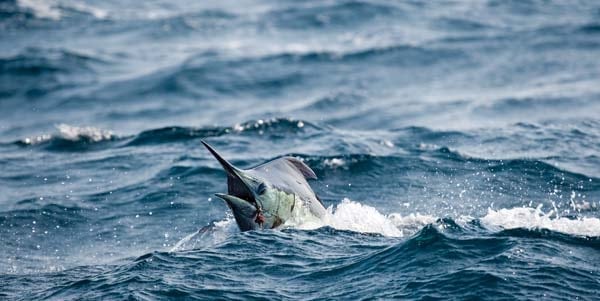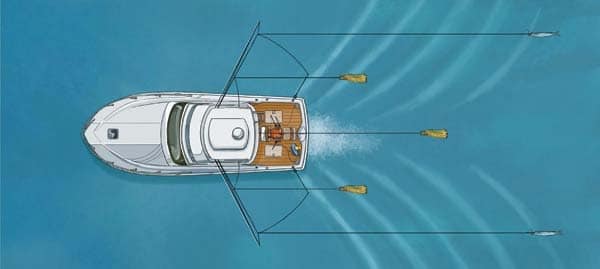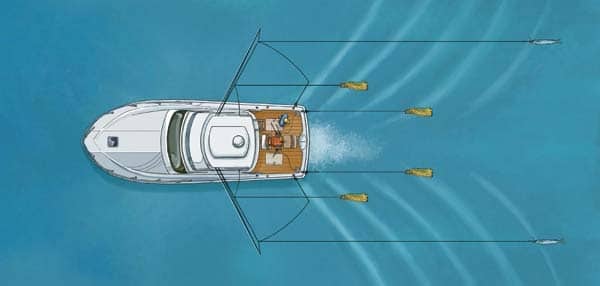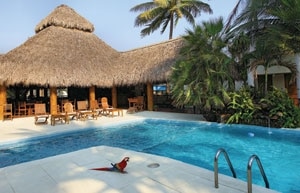
One of my favorite things is bait-and-switch trolling for Pacific sailfish. Hamlin has tagged and released over 10,000 billfish during his long career, and he has probably forgotten more about this style of fishing than most captains will ever know.
Hamlin, photographer Richard Gibson and I stare at the baits from the bridge, and when a sailfish shows up, everyone in the cockpit moves instantly into a well-rehearsed routine; there’s no panic or pandemonium here. The fish rises to a hookless teaser riding on the face of the second boat wake, to the left. The mates grab the teaser lines as my wife, Poppy, picks up a 30-pound conventional outfit and pulls a waiting ballyhoo rigged on a circle hook from its pitch-bait tube and drops it over the transom.
The sailfish slashes at the hookless lure, but the mate keeps it in perfect position until Poppy’s ballyhoo falls back into position. When she’s ready, he yanks the teaser from the spread, and the fish, still fired up and hungry, piles onto the ballyhoo and takes off with its meal. After a brief drop-back, Poppy throws the reel into gear and winds hard, keeping her rod tip low and slowly sweeping the rod to the side when the line comes tight.
Off to our right, the sailfish leaps skyward as it feels the sting of the circle hook and heads off toward the horizon in an incredible series of acrobatic jumps, trying to rid itself of the hook. It won’t be able to, however, because the circle hook, as is typical, has found the corner of the fish’s jaw perfectly and is well-set. The sailfish subsequently sounds, but after a few minutes of steady pressure, Poppy has the fish at the transom corner, where one mate takes a wrap on the leader while the other mate plants a tag in the tired fish’s shoulder. The leader is cut, and the fish is free again as the crew celebrates and marvels once more at the effectiveness of the bait-and-switch.

Keep It Simple
The simplicity of bait-and-switch fishing makes it so brilliant. You troll several hookless teaser baits, with or without a hook bait or two in the spread, and keep rigged hook baits ready to drop back when a fish pops up.
Most captains in Guatemala rig a pair of 30-pound conventional rods with ballyhoo on circle hooks for sailfish, with a 50-pound outfit rigged with a small tuna in case a marlin rises to the teasers. By using this method, you make sure you’re neither overgunned nor undergunned, no matter what fish shows up.
When trolling in the conventional manner, i.e., with hooks in everything in your spread, you’re stuck with the tackle you have out. If a large marlin jumps on a 30, you could be in trouble. Conversely, if a sailfish eats a bait on a 50, the fight is boring. Bait-and-switch allows you to perfectly match tackle to fish. This is especially true if you want to use light tackle or fly-fish.
Bait-and-switch has almost limitless applications, and if you’re after billfish, especially Pacific sailfish, there’s no better place to try it than the Pacific coast of Guatemala. Both Hamlin and Capt. Chris Sheeder, whom we fished with as well during our trip, work out of Casa Vieja Lodge (see the SWS Planner), which has quickly become the top fishing outfit in this part of the world. As we relaxed around the Casa Vieja pool one afternoon, I asked Hamlin and Sheeder to discuss their respective bait-and-switch philosophies.
Pull the 4-Eyed Monster
Both Hamlin and Sheeder like Mold Craft lures for their teasers. “I pull nothing but Mold Crafts, but the color doesn’t really seem to matter,” Hamlin said. “The standard 9-inch 4-Eyed Monsters work great, and I raise as many blue marlin as anybody using larger teasers.” Hamlin goes on to say that the lures play a secondary role in raising fish, however. “The boat is the teaser, not the thing dragging behind it,” he said.
“I fish two baits with hooks in my riggers and run two bridge teasers about as far back as where my flat lines would be,” Hamlin continued. “Then I put a third teaser down the center, midway between the bridge teasers and my long rigger baits. My two flat-line baits are sitting in pitch-bait tubes with water in them so the baits don’t dry out and get stiff but are ready to be put in use at a second’s notice.”
Note that Guatemala has long been ahead of the rest of the world in terms of conservation, and circle hook use is mandated by law, as is the release of all billfish.

A Different Approach
Sheeder’s spread resembles Hamlin’s in many ways but has subtle differences. “When the bite is on and I’m trolling slower, I drag mostly Mold Craft lures, and maybe a Pakula or Ilander,” Sheeder said. “When searching and trolling faster, I’ll drag my Hawaiian stuff – Joe Yee, Marlin Magic – for a little more movement behind the boat. Specific color is not too important, but I will have a variety of colors out at any given time, and if by chance a particular color is getting bit, I’ll double up on it.”
Sheeder runs bridge teasers very close to the transom, on the second wave, where they can be snapped out of the water quickly and easily. “I also pull two flat-line teasers on the third wave when fishing is hot and heavy and we’ve slowed down a touch, or on the fourth wave when searching at higher speed,” he added. “Two rigged outrigger ballyhoo hook baits on the fifth or sixth wave clean everything up.
“When a fish comes to a teaser – doesn’t matter which side – anglers pitch a bait on both sides of the boat,” Sheeder continued. “Obviously, the angler on the side with the fish will be dropping back to the fish while the angler on the other side will be dropping back to the area behind the bridge teaser and in front of the flat, being in position for a second fish or in case the initial fish switches sides. We use bait tubes with iced salt water to keep the baits ready. This is more important than it sounds. If you just have your baits lying around, they dry out; hang them outside the cockpit, and they start to smell like diesel fumes; keep them in the cooler, and they’ll get caught up on all the other leaders. Keep it clean, organized and simple. If a fish comes up on an outrigger or falls back out of teaser range, you have those outrigger baits for cleanup.”
Efficient and Effective
Bait-and-switch is a model of efficiency and effectiveness when done right, and Hamlin and Sheeder are two of the best at it. Where they fish, out of Puerto Quetzal, on Guatemala’s Pacific coast, the fishing can be fantastic: On a single day in March of 2006, for instance, both Hamlin and Sheeder set records that will likely stand for some time. Hamlin and his crew caught and released an incredible 124 sailfish on conventional tackle, using the bait-and-switch technique, and on the very same day, Sheeder and Casa Vieja owner Jim Turner caught and released 57 sails on fly rods, also using bait-and-switch. Those are staggering numbers in anyone’s book.
So given those numbers, can you count on getting 50 shots or more every day in Guatemala? Of course not. Fishermen there have good and bad days, just like everyone else. That’s fishing, as the saying goes. You can take this to the bank, however: You have a better chance at multiple Pacific sailfish shots (and remarkable numbers of blue marlin, in recent years) in Guatemala than in any place else on Earth, and if you’re lucky enough to wind up on a boat with either Hamlin or Sheeder, your chances improve dramatically.
Top-quality tackle is provided on all boats, but if you want to target sailfish, marlin, tuna or dorado on a specific type of gear, bring it along. In general, the following works best.
Rods: To match the reels outlined below. Fishing in Guatemala is done almost exclusively stand-up style, so bring appropriate harnesses and belts if you prefer to use your own.
Reels: Conventional 30-pound-test reels with large line capacities and smooth drags for sailfish, 50-pound outfits for marlin. Casting or fly reels to suit your desires.
Lures: Mold Craft hookless teasers. Specifically, 4-Eyed Monsters, Wide Ranges and Hookers.
Hooks: 5/0 to 7/0 circle hooks on rigged baits for sailfish, 10/0 to 12/0 circle hooks for marlin.

Casa Vieja means old house in Spanish, and that’s what this incredible lodge grew out of. But the original home is hard to recognize after all of the stunning additions owner Jim Turner has built. Casa Vieja’s staff pampers you from the moment you arrive, providing an all-inclusive experience that is simply luxurious.
The lodge features a new outdoor bar and restaurant and, since our first trip a few years ago, a new wing of comfortable, air-conditioned guest rooms. After a day of fishing on one of the lodge’s fleet of eight custom sport-fishing boats (the fleet of boats comes from a veri- table who’s who of custom boatbuilders), you’re greeted upon your return from the marina with a cool drink of the day before you make your way to the pool, where hors d’oeuvres are served daily. It adds up to great fishing and great service, a combination you’ll find hard to beat.
Casa Vieja Lodge
2550 S. Bayshore Drive
Suite 206
Miami, FL 33133
800-882-4665
305-854-4665
www.casaviejalodge.com









